Synology DiskStation DS1621xs+
Unless some global event throws a complete spanner in the works, most small businesses eventually become bigger, and that growth expands the need for better IT infrastructure that can support a larger workforce.
For business users, Synology provides a complete path that starts with relatively low priced dual-drive NAS solutions and ultimately progresses to rack-mounted monsters that can support hundreds of terabytes of live data and a workforce working over multiple sites.
Part of its success has been how it places those stepping stones and what each rung of its performance ladder delivers over those below.
The new Disksation DS1621xs+ sits neatly between the value series designs, like the old DS1817 workhorse and the rack-mounted XS, XS+ and SA series machines.
Being from the XS+ stable, it combines enhanced processing power with extensive upgradability. Making it ideal for those that need plenty of headroom for projects that can expand in scope and personnel rapidly.
Synology also fixes some of the shortcomings of the base DS1621+ and lesser brothers in this design, but not all.
Is this hardware truly worth the steep asking price for what might get exclusively used as a file server or backup facility?
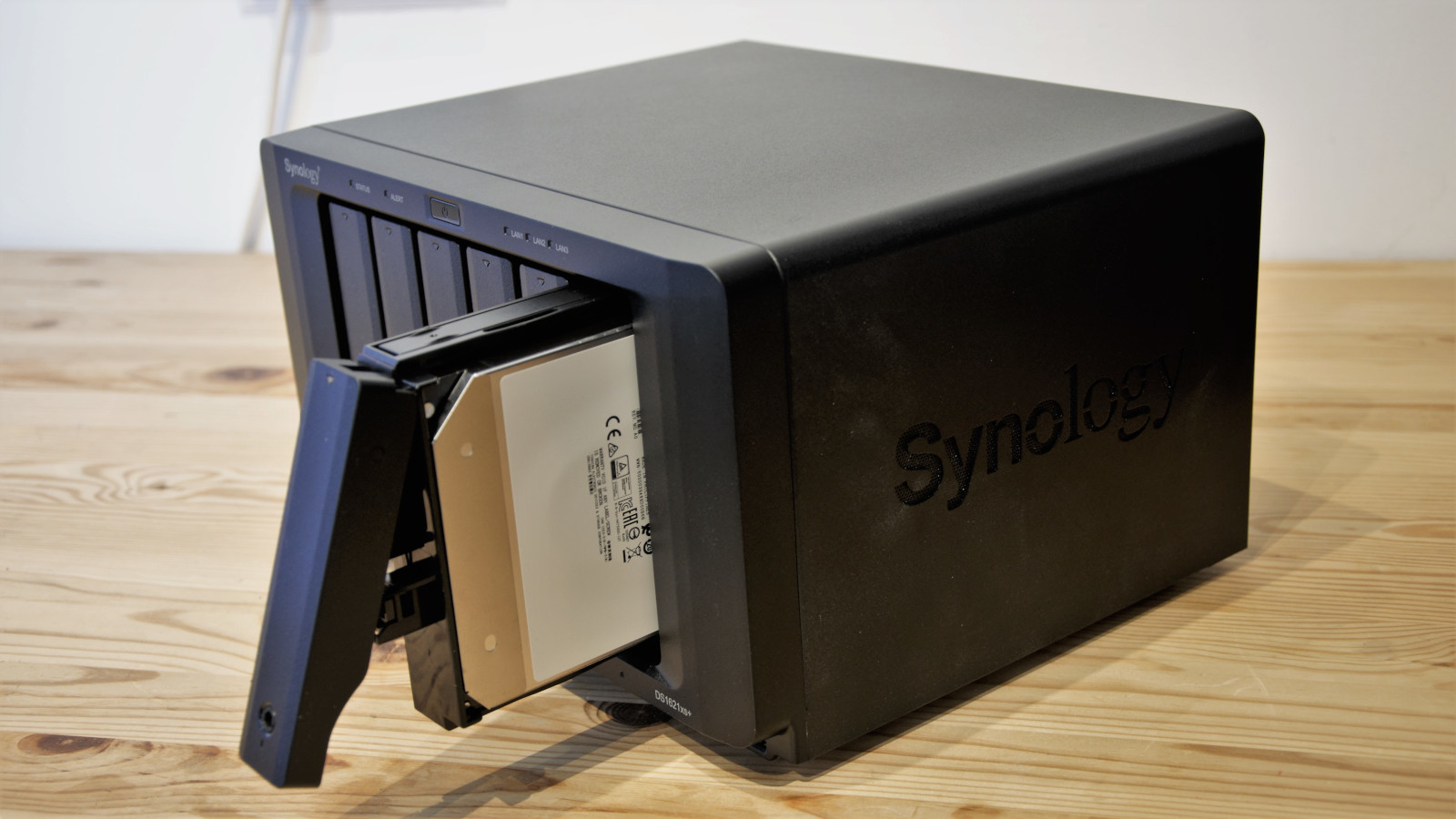
Pricing and availability
The standard DS1621xs+ unit with no drives included costs around £1,520 in the UK and $1,649.99 in the USA.
Our review unit came with six Synology HAT5300 RackStation hard drives, three each of the 8TB and 12TB capacities, costing $239.99 and $349.99 separately.
They also provided two ANV3400-400G 400GB NVMe cache modules, costing $149.99 each, and a Synology branded 16GB EEC SODIMM memory chip, another $367.49.
That’s a total of $4,087.40 for the system reviewed here, including the cache, extra RAM and 60TB of raw drive capacity.
For those wishing to expand the machine further, Synology makes the DX517 5-bay expansion box costing £467.45 ($469.99) without disks, and you can connect two of these.
And finally, the PCIe slot can accept a range of LAN NIC cards to provide extra 25GbE, 10GgE, 2.5GbE or 1GbE ports as required. Prices for those vary, according to how many ports they add, and what speeds they can run.
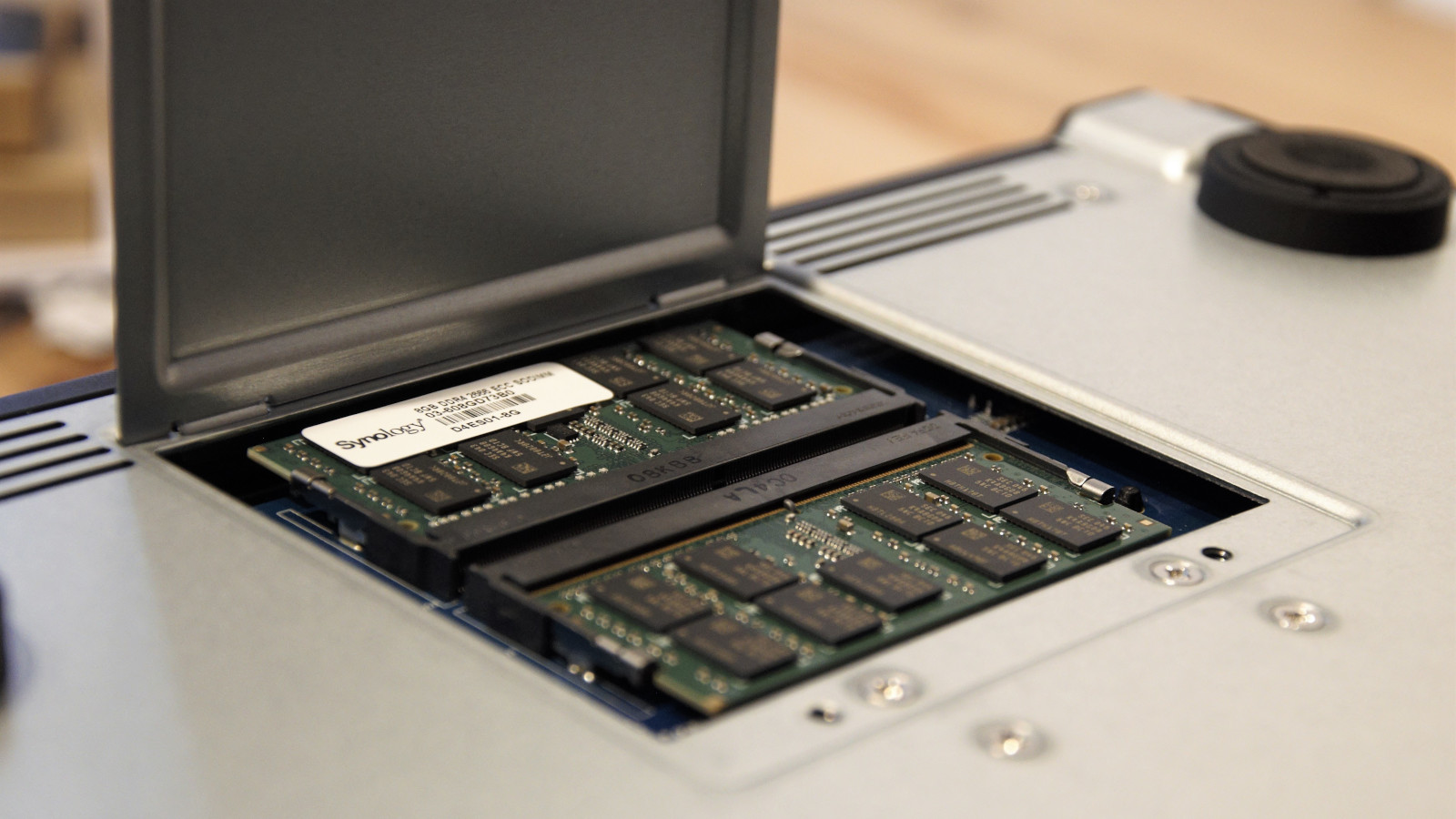
Design and features
With the DS1621+ machines, Synology wanted to divide it from other products that are more orientated for home use and so didn’t provide activity LEDs for the drives as we’ve seen on different designs.
Instead, our review hardware was provided along with some Synology branded hard drives that all sported an edge-mounted LED that’s visible through a tiny window in the drive tray doors.
But in all other respects, the DS1620xs+ has the same design motif that Synology has promoted for some years now, where black is beautiful and will never collect dust.
It’s almost identical to the DS1621+, a narrower derivative of the enclosure that appeared on the DS1817 back in 2016.
On the front are the six plastic tool-less drive trays, some LED indicators, a power button, and a single USB port tucked away in a location that is easy to miss. There is no button to transfer files from that USB port, so it might have been better to place it around the back with the two other USB 3.1 gen 1 (USB 3.0) ports that are in this version.
Here is the configuration of the Synology DiskStation DS1620xs+ TechRadar reviewed:
CPU: Intel Xeon D-1527
RAM: 24 GB DDR4 non-ECC (1x 8GB and 1x 16GB SO-DIMM)
Storage: 6x 3.5" SATA HDD/SSD (3x 8TB, 3x 12TB), 2 x 400GB M.2 2280 NVMe SSD
LAN ports: 2 x 1GbE (RJ-45), 1x 10GbE
External ports: 2 x USB 3.1 Gen 1, 2 x eSATA
Expansion: Via eSATA (2 x DX517) for 10 extra drive slots, 1x PCIe 8x slot
Weight: 5.3 kg without drives
Size: 166 mm x 282 mm x 243 mm (W x D x H)
Warranty: 5-year limited
With all the trays removed, access is possible to two NVMe slots on the inner wall, and for our testing, Synology provided two SNV3400 400GB modules to cache the conventional storage pool available.
A removable panel on the underside reveals the two SODIMM memory slots, one of them occupied by default with an 8GB DDR4 ECC module. The review hardware came with an additional 16GB module which we mounted in the empty slot, and it is possible to expand the memory to 32GB by putting 16GB of RAM in each.
As the box includes an internal PSU bringing its empty weight to over 5KG, we’d strongly recommend that any NVMe installation or memory upgrades are made before installing drives, as it gets cumbersome once they’re added.
At the rear are the majority of connectivity options, with three LAN ports (2x 1GbE and a single 10GbE, two eSATA expansion ports and the two aforementioned USB ports.
There is also a card slot on this design enabling additional LAN ports to the added from a compatible selection that includes Synology’s own designs plus those from Intel and Mellanox. The PCIe slot behind this is PCIe 3.0 8X electrically, enabling a maximum of four 10GbE or two 25GbE ports to be added.
It might be possible to add other things beyond LAN ports using this slot, but Synology only mentions these devices as being specifically compatible.
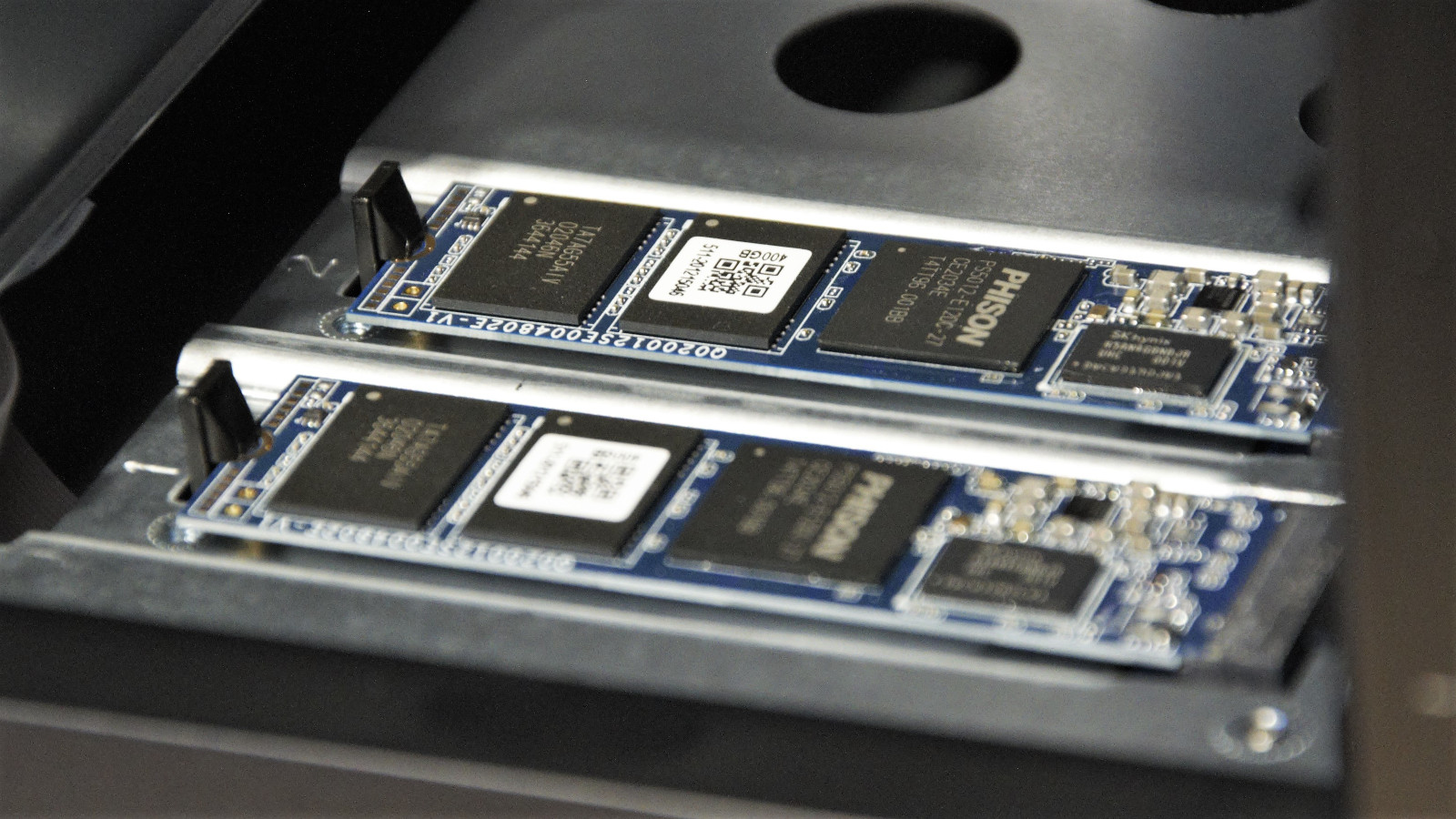
The key differences here over the base DS1621+ are that it has a different (not necessarily better) CPU, a 10GbE port and two 1GbE ports instead of four 1GbE, and the OS is configured for more simultaneous connections, volumes, greater single volume size and more user accounts.
But realistically, most owners will never reach the numbers of connections and users that the DS1621+ supports, never mind the extra that the DS1621xs+ can theoretically handle.
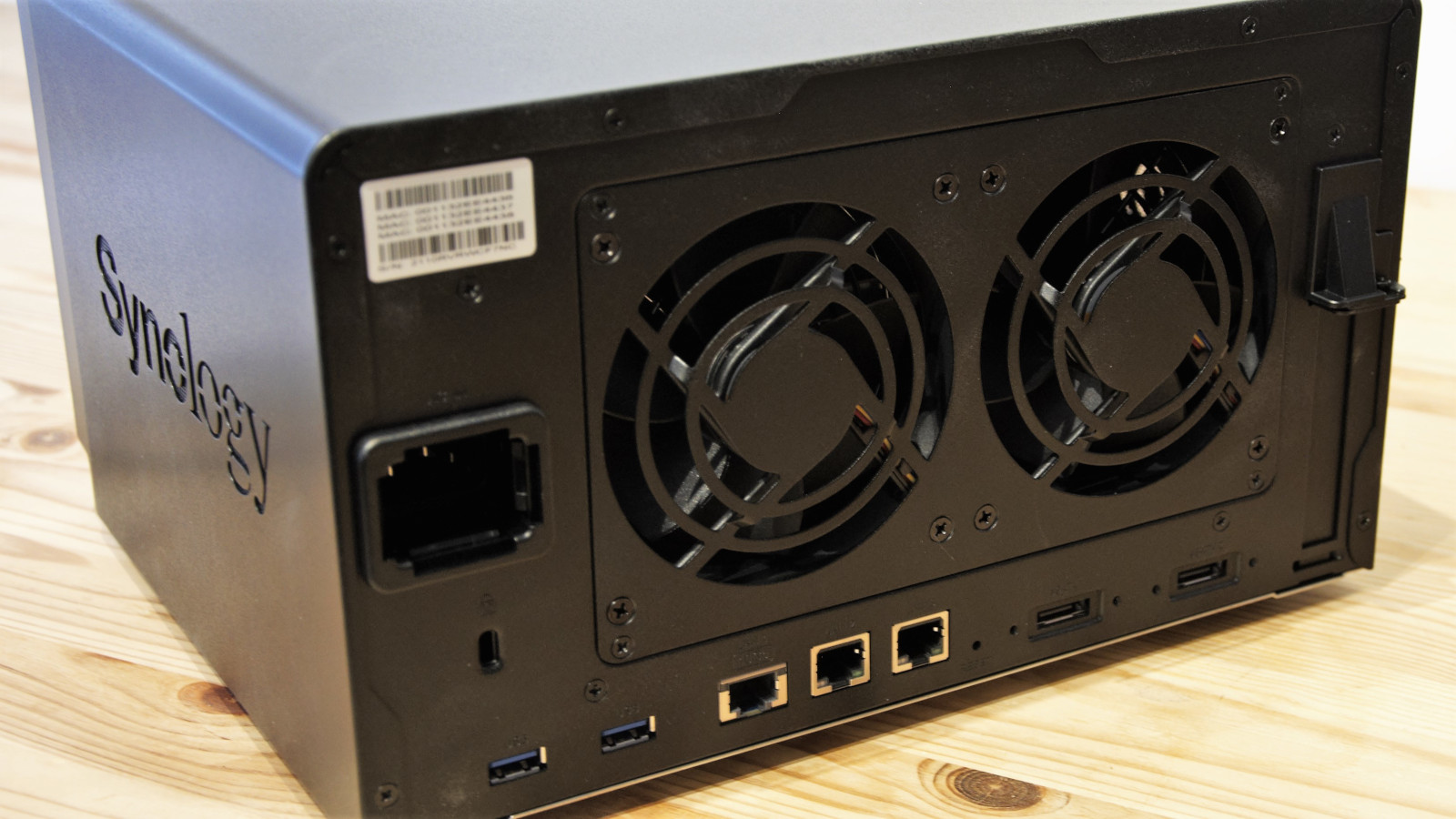
Performance
With a modest Xeon processor inside, most customers would expect good performance from this platform even under loading, and it does run well.
This XS+ variant uses an entirely different architecture to the standard DS1621+ that uses an AMD Ryzen V1500B, where this has the Intel Xeon D-1527 at its heart.
On paper, the difference between these chips is remarkably small, as they are both quad-core, 2.2GHz base clock 64-bit processors.
The older Xeon D-1527 (2015) can turbo boost to 2.7GHz as required and has a little extra On-chip L2 + L3 cache, but the newer AMD Ryzen V1500B (2018) is dramatically more power-efficient.
The AMD chip uses a maximum of 16 watts, where the Intel chip consumes more than double that at 35 watts. Considering that most NAS boxes remain powered 24/7, this might have been an excellent reason to stick with the AMD CPU.
Benchmark’s put these processors as very close, maybe with a slight advantage to the Intel chip, but this processor alone hardly justifies the significant price difference between the DS1621+ and the DS1620xs+.
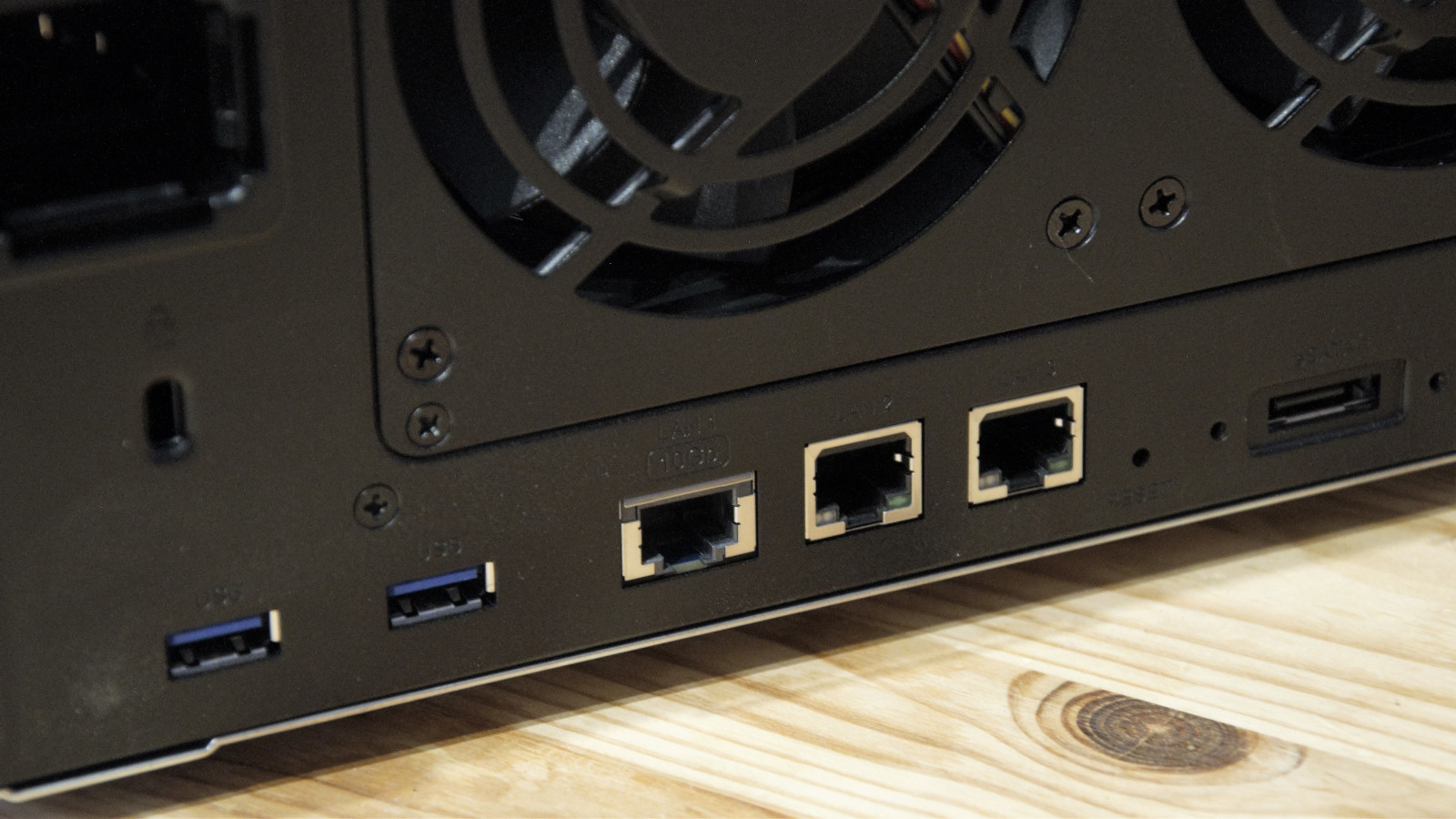
For anyone buying either the DS1621+ or DS1621xs+, the range of performance that is available is wide, as both offer LAN connectivity that can be significantly upgraded.
The DS1621xs+ addresses many of the bandwidth concerns that we’ve expressed when covering products like the DS1520+. These lower spec machines have plenty of drives, a decent amount of processing power, caching, and the same expansion possibilities of using the external DX517 option.
But they lack the 10GbE networking needed to distribute this power, and by using the PCIe slot, the DS1621xs+ can add another four of these ports to the one it gets inherently.
Five 10GbE ports can support many users simultaneously, but having this much network bandwidth shifts the logjam elsewhere. That place being internally SATA III, and the external eSATA connections.
With each of the external boxes only capable of around 500MB/s transfers, the burden falls on the internal storage and roughly 1,200Mb/s of throughput using conventional hard drives. Even combined and supported by NVMe caching, this drive system couldn’t keep a potential 52Gbit/s of network bandwidth fully saturated.
There are two possible solutions to this problem, neither of which Synology seems keen to embrace.
One of those is to allow the NVMe drives configured as high-speed storage and not just cache. And, the second if for them to use a more concurrent and appropriate external storage technology, such as Thunderbolt 3 or USB 4.0.
That this machine is still using USB 3.0, now renamed USB 3.1 Gen 1, is more than disappointing. Maybe it is that Synology didn’t want third party hardware to eat its DX517 sales by using USB 3.2 Gen 2 or even Gen 2x2 to provide 10Gbit or 20Gbit paths for external data, and not the 6Gbps maximum of eSATA.
In conclusion, the performance of this unit is good, but it might have easily been even better if Synology would only replace the DX517 and stop flogging the long-deceased equine that is eSATA.
Competitors
The price of the DS1621xs+ is a problem considering some of the more affordable alternatives available.
Netgear has its ReadyNAS 626X costing about half the price, with six bays, the same Xeon CPU and dual 10GbE ports as standard and a PCIe slot free. But, it only has a single eSATA port and 8GB of RAM.
However, with the free PCIe slot, this machine might be upgraded with Thunderbolt or more 10GbE ports at a greatly reduced cost over the DS1621xs+.
Another model that undercuts the Synology offering by almost half is the Asustor LOCKERSTOR 8 (AS6508T), an 8-bay NAS using the Intel Denverton-based Atom C3538 Quad-Core CPU. It comes with two each of 10GbE and 2.5GbE LAN ports, up to 64GB of RAM, and two USB expansion boxes that can increase the number of drives to 16.
But the biggest challenge this product has is Synology’s own DS1621+ model, which includes almost everything in the DS1621xs+ with the exception of the 10GbE LAN port.
As it uses a more power-efficient CPU, it can be upgraded to 10GbE via the PCIe slot and runs the same impressive selection of DSM applications.
Synology does give the DS1621xs+ a five-year warranty, two more than its sibling, but it is possible to take out a warranty extension to match this for around $100.
Based on the excessive price difference between these remarkably similar machines, it might be more cost-effective to buy two DS1621+ systems and sync the contents using a dedicated PCIe card 10GbE backchannel connecting them than to use a single DS1621xs+ and an expansion box.
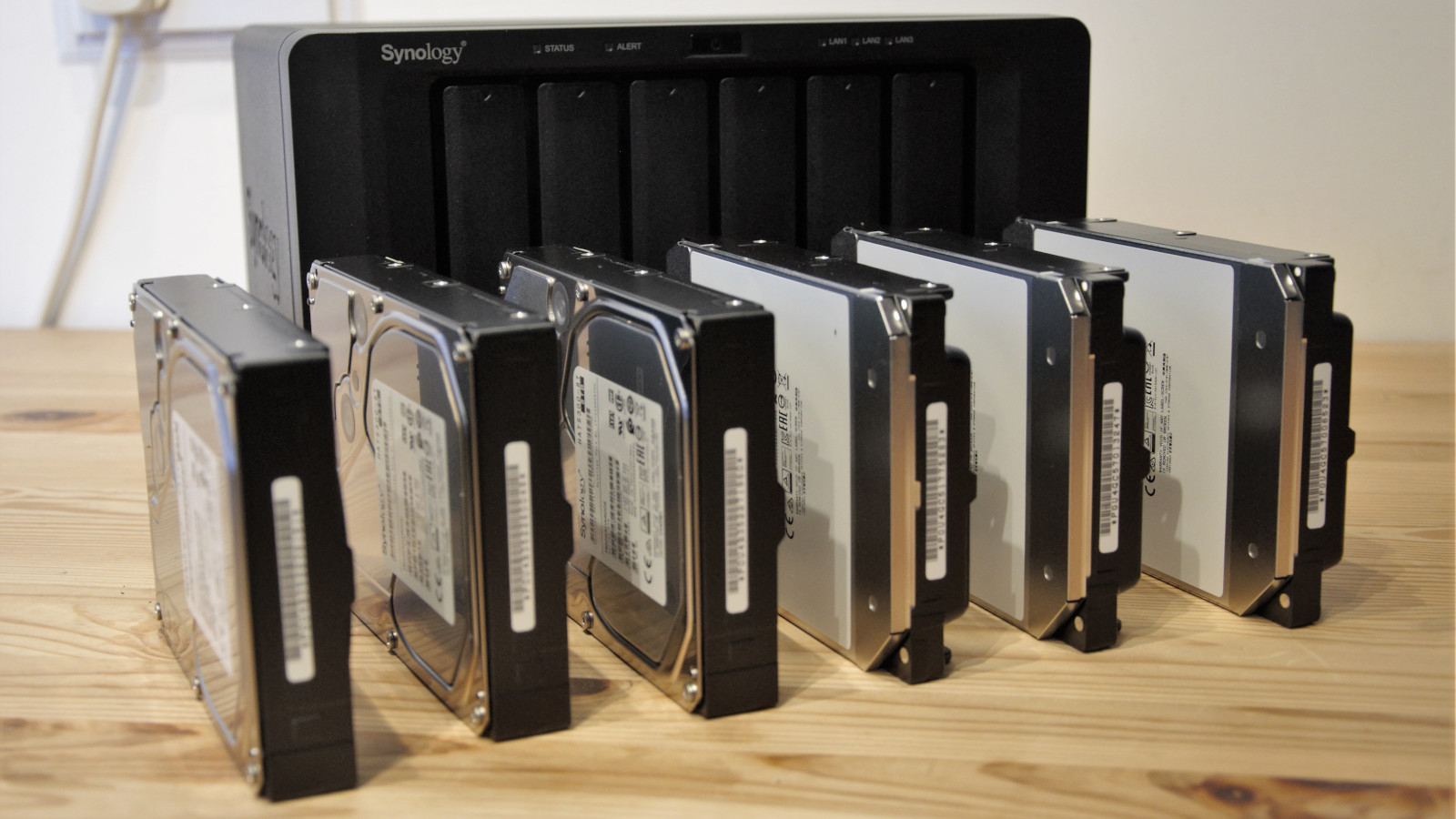
Final verdict
A deep dive into the DS1621xs+ doesn’t come up with any plausible explanation as to why it is double the cost of the base DS1620+ when its only significant upgrades are a Xeon processor of dubious value and a single 10GbE port.
Yes, the DS1620xs+ can handle 2,000 concurrent connections, double that of the DS1620+, but the number of scenarios where a business would point that many users at this hardware are limited.
If anything, the DS1621xs+ makes us appreciate how good a deal the DS1621+ might be, if nothing else.
That said, when you consider that mounting six 12TB Synology branded drives inside this NAS will cost an additional £2,200 or more, then maybe the cost of the box a lesser factor.
Overall, the DS1621xs+ is a solid platform, undermined by a Synology strategy that wants to keep the ageing DX517 and eSATA technology from 2004, relevant today.
Those considering this should seriously consider the excellent DS1621+ with a 10GbE LAN card and save themselves a chunk of change.
0 comments:
Post a Comment